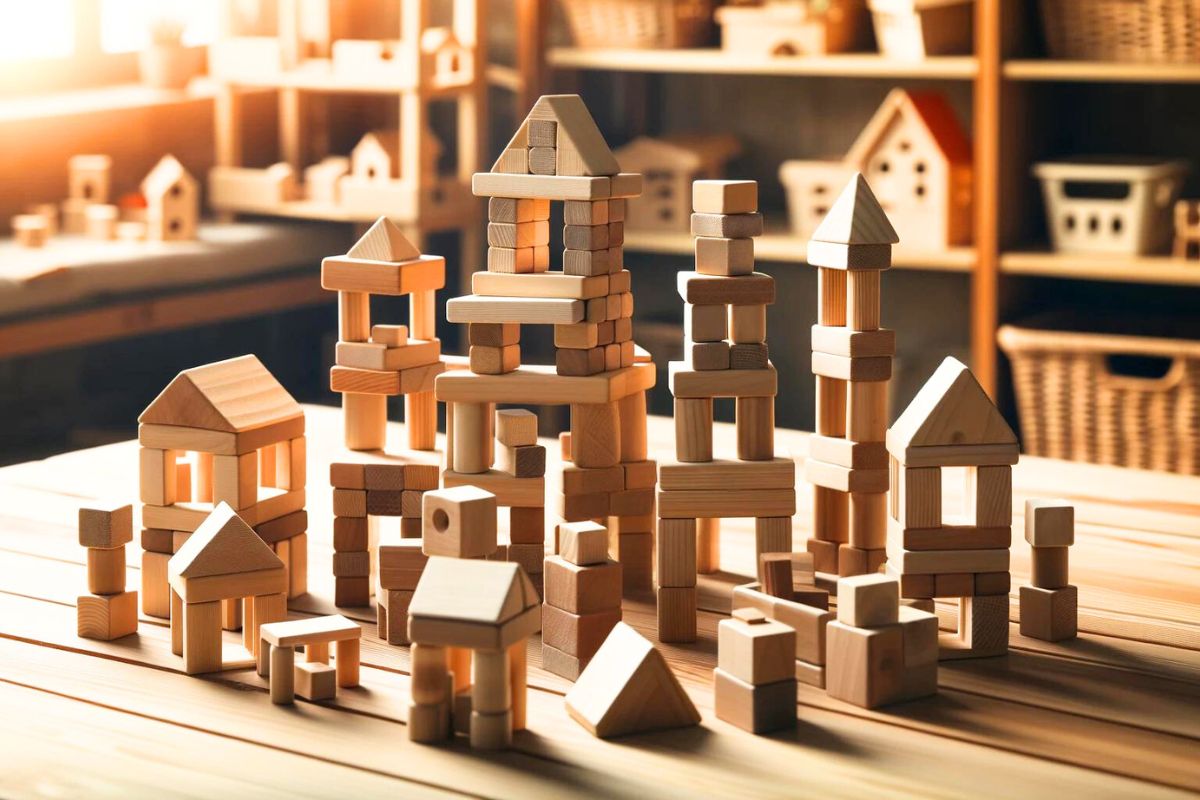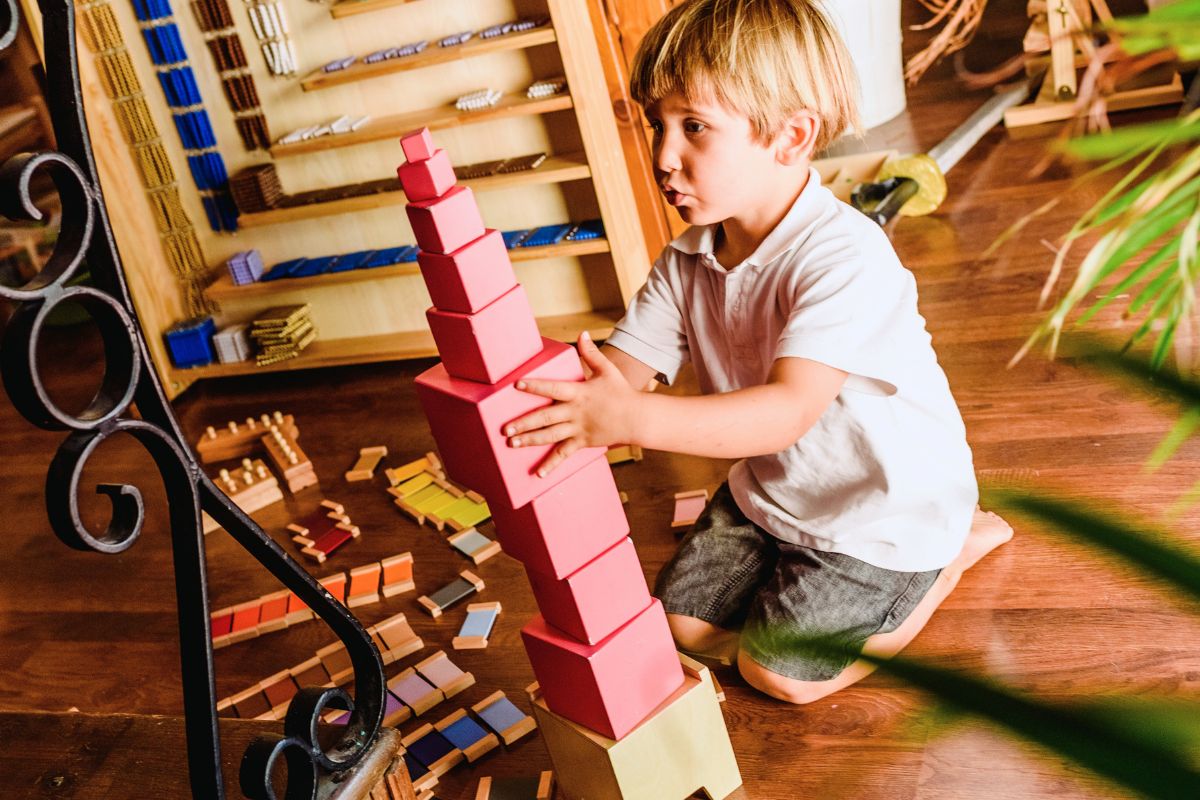Have you ever watched a child completely captivated by a pile of wooden blocks? In a Montessori classroom (or even at home!), those simple wooden blocks become more than toys – they transform into launchpads for imagination, engineering feats, and endless possibilities for exploration. This isn’t just playtime; it’s a journey of learning and development!
Top 15 Montessori Block Building Ideas
- Block Maze: Encourage spatial reasoning by creating a complex maze on the floor with blocks. Children can navigate a toy through the twists and turns, enhancing their problem-solving skills and understanding of directionality.
- Architectural Wonders: Introduce children to world geography and architecture by building famous landmarks like the Eiffel Tower or the Pyramids of Giza. Discuss the historical and cultural significance of each structure to deepen their global awareness.
- Color Sorting: Develop color recognition and sorting skills by using colored blocks. Children can create patterns and sequences, which helps in understanding the basics of mathematics and organization.
- Nature-Inspired Structures: Foster a connection with the natural world by constructing trees, animals, and other nature-inspired shapes. This activity encourages children to observe and replicate the beauty of nature’s designs.
- Community Helpers: Teach about community roles and services by constructing buildings like fire stations, hospitals, and schools. Role-playing with these structures can help children understand and appreciate various professions.
- Symmetry Challenge: Challenge children to create symmetrical structures, which promotes an understanding of balance and aesthetics. Discussing symmetry can also introduce basic geometry concepts.
- Block Puzzles: Enhance critical thinking by arranging blocks to fit into a predetermined space, similar to a puzzle. This activity requires precision and spatial awareness, as well as patience and concentration.
- Storytelling with Blocks: Encourage language development and narrative skills by building scenes from stories. Children can retell the narrative or create their own, fostering imagination and sequencing abilities.
- Height Challenge: Inspire friendly competition and engineering skills by seeing who can build the tallest stable structure. This challenge teaches about gravity, balance, and the importance of a strong foundation.
- Balancing Act: Place blocks on a balance board and experiment with weight distribution. This activity is excellent for understanding physics concepts and improving hand-eye coordination.
- Geometric Patterns: Use blocks to create geometric patterns and shapes. This helps children recognize geometric terms and understand their properties.
- Letter and Number Formation: Encourage literacy and numeracy by forming letters and numbers with blocks. This activity aids in letter recognition and basic math skills.
- Sensory Exploration: Incorporate blocks with different textures for sensory play. This stimulates the sense of touch and can be calming for children who need a sensory break.
- Construction Challenges: Set up challenges where children have to build a structure based on a specific set of criteria, such as using only a certain number of blocks or creating a structure that can hold a certain weight.
- Cultural Structures: Build structures that represent different cultures, such as igloos, teepees, or pagodas. This activity can be integrated with lessons about world cultures and habitats.
Why Block Building Matters
Block building is more than just play. It’s a foundation for learning. Through block play, children develop:
- Explore spatial concepts: Through building, children develop an intuitive understanding of size, shape, balance, and gravity.
- Refine motor skills: Stacking, sorting, and manipulating blocks enhance fine and gross motor coordination.
- Express themselves creatively: With endless possibilities, blocks become a blank canvas for their imagination to take flight.
- Develop social skills: When children build together, they learn to share, collaborate, and resolve conflicts in a positive way.
The Montessori Approach to Blocks
Montessori education is grounded in hands-on learning and self-directed activities. In this environment, block play is a form of open-ended creativity, fueled by the child’s own imagination. It involves offering children the freedom to explore and create without rigid guidelines.
The aim is to empower the child’s imagination and comprehension of the physical world to steer their construction endeavors. This method cultivates independence and honors the child’s innate developmental trajectory, thereby nurturing a passion for learning and exploration.
Montessori Materials Block Building Ideas
The Pink Tower & Brown Stairs
The Pink Tower and Brown Stairs are classic Montessori materials. The Pink Tower consists of 10 progressively smaller cubes, while the Brown Stairs feature prisms that vary in height but are consistent in length. Children can use these concepts to create their own structures, learning about size, weight, and balance in the process. This hands-on experience introduces basic mathematical concepts and the principles of design.
Knobbed Cylinder Blocks
These blocks help refine a child’s visual and tactile senses, as they involve matching cylinders of different dimensions to their respective holes. Encourage children to use these cylinders as the foundation for more complex structures, integrating them with other blocks to create unique shapes. This activity not only enhances sensory perception but also encourages logical reasoning and critical thinking.
Creative Free Play
Provide a variety of wooden blocks and let children’s imaginations run wild. They can build towers, houses, bridges, and whatever else they envision. Through trial and error, they’ll learn about structural integrity and the properties of different shapes. Free play with blocks also promotes creativity, as there are endless possibilities in what they can create.
Interlocking and Textured Blocks
Blocks that interlock or have different textures add another dimension to block play. Children can explore how these blocks fit together and the sensory experience they provide, which is especially beneficial for younger children still developing their fine motor skills. These blocks also introduce the concepts of cause and effect and problem-solving as children figure out how to connect them.
The Magic of Block Play
The simple act of block play, thoughtfully curated within a prepared environment, empowers children to become active participants in their own learning journey. By providing open-ended materials and fostering independent exploration, this approach cultivates a love for discovery, problem-solving, and a lifelong love of learning that extends far beyond the playroom.




